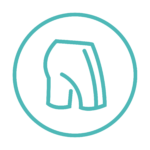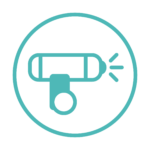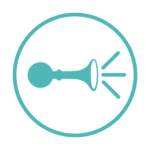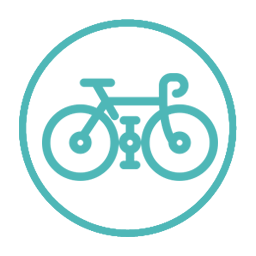Lesson Plans by Grade level
Your Gear

- A bike should fit its rider – one that is too big or too small cannot be controlled properly.
- The bike should be legally ready to ride: all bikes need lights, reflective strips, and a bell.
- Keep your bicycle in good repair.

- The best helmet is one that fits properly, is worn correctly and has been manufactured to meet strict safety standards. Look for a safety standards sticker meeting the approval of safety organizations such as the Canadian Standards Association (CSA), Snell, ANSI, ASTM, BSI, CPSC and SAA.
- Follow the 2V1 rule for proper helmet fitting:
- There should be two finger widths between your eyebrows and the helmet.
- The straps should be flat against the face.
- The side straps should meet just below the ear making a V-shape under your ear lobe.
- The chin strap should be fastened snugly with enough room to fit one finger between your chin and the strap.
- A helmet works by absorbing the forces of a crash, so if the helmet has been in a collision, it should be replaced even if there is no visible damage.
- Every cyclist under the age of 18 must wear an approved bicycle helmet in Ontario, by law.

- Clothing can improve or reduce visibility. Yellow and white stand out best at night; dark colours are difficult to see.
- Pedal reflectors and reflective material on wrists, ankles, heels, clothing and helmets help others see you.
- Always wear closed-toe footwear on a bicycle.
- Do not wear headphones while riding a bicycle – it’s important to stay alert while on the road.

- By law, your bicycle must have a white front light and a red rear light or reflector when you ride between one-half hour before sunset and one-half hour after sunrise.
- The law requires white reflective strips on the front forks and red reflective strips on the rear stays of your bicycle.

- By law, all bikes must have a working bell or horn to announce your approach.
- Bicycles are very quiet vehicles, so it is important to warn other cyclists and pedestrians that you’re coming.
- It can be just as effective and more courteous to shout something like “passing on the left” when overtaking other cyclists and pedestrians.
On the Road
- Learning how to safely ride a bicycle takes practice.
- After practicing safe cycling skills you can try a road test to review.
- Riding in a straight line is the key to riding safely in traffic. Ride in the same direction as traffic on the right side of the road.
- To practice, try following a painted line in a parking lot. Try not to move your upper body as you pedal – let your legs do the work.
- When riding with a buddy, ride in single file.
- To make a safe turn in traffic, you have to look over your shoulder.
- Looking backwards can make it difficult to maintain a straight line. Practice your straight line riding in a parking lot while checking behind you over both shoulders.
- Know appropriate hand signals to indicate your intentions to drivers, pedestrians and fellow cyclists.
- Always using your left arm, hold it out straight for left, up for right, and down with your palm facing back for “slow down.”
- Make certain it is safe to turn before moving by doing an over-the-shoulder check.
- Shift into a low, easy gear before you stop.
- Use low, easy gears when going up hills. Shift into lower gears before you begin to work too hard.
- Use higher, harder gears when you begin to bounce on the seat from pedalling too fast. Avoid pedalling slowly and pushing hard in your highest gears.
- Stop for all stop signs.
- Stop at all intersections and before crossing driveways, paths and sidewalks.
Resources
- Young Cyclist’s Guide. Ontario Ministry of Transportation
- Helmet Safety. Toronto Helmet Initiative
- Bike Safety. CAA National
- Cycling Safety. CAA South Central Ontario
- Walk and Wheel Events. Ontario Active School Travel
- Cycling. Parachute
- Safety on Wheels. Elmer the Safety Elephant

